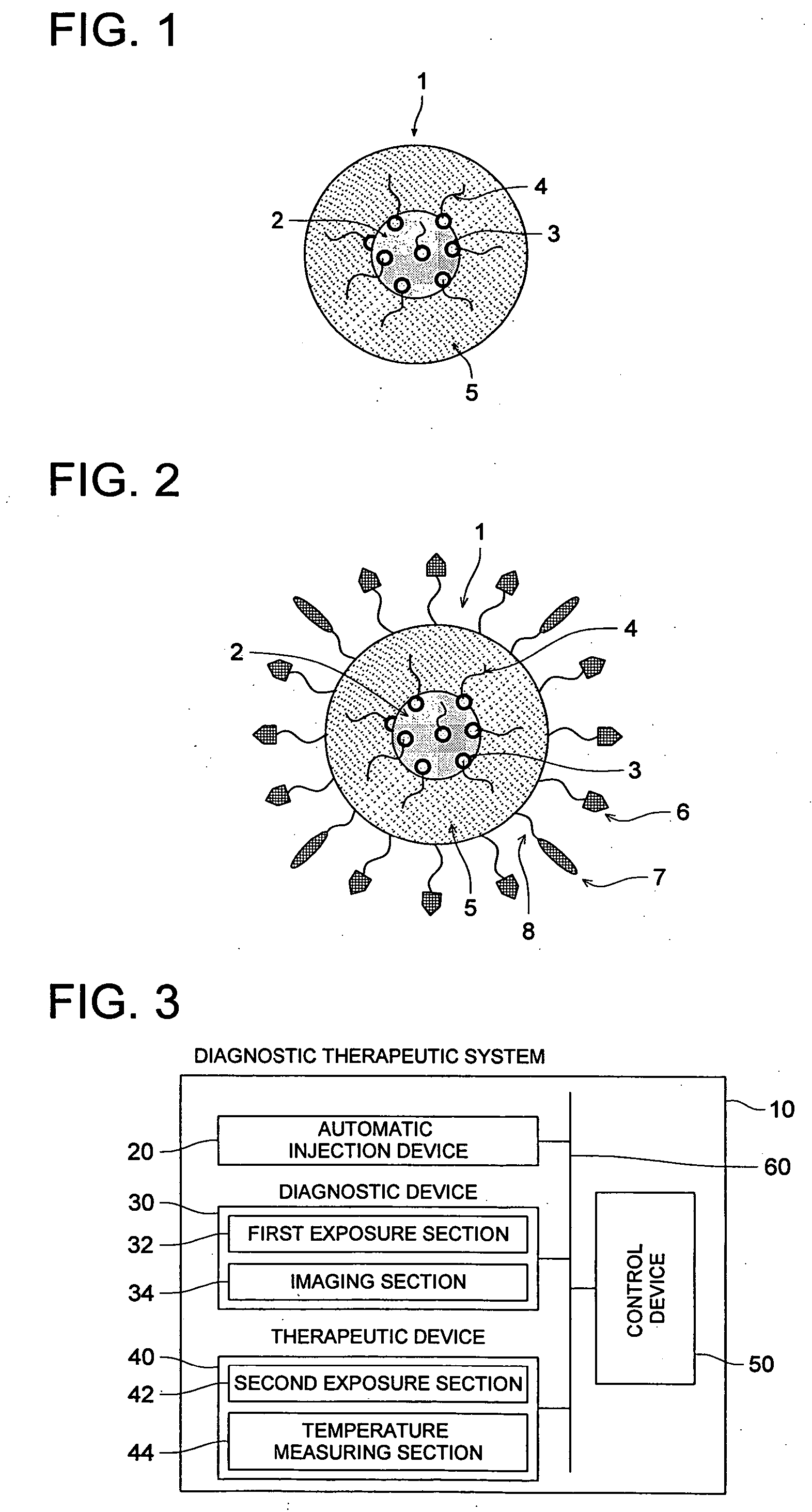Pharmaceutical preparation containing magnetic vesicular particles, manufacturing method thereof and diagnostic therapeutic system
- Summary
- Abstract
- Description
- Claims
- Application Information
AI Technical Summary
Benefits of technology
Problems solved by technology
Method used
Image
Examples
example 1
Formation Method 1 of Magnetic Microparticle.
[0169] To 50 ml of an aqueous 1 wt % PVA solution were added magnetic microparticles comprised of ferrite, as shown in Table 1, 8.5 mg of HAuCl4 (4.9 mg Au and its concentration of 0.5 mmol / L), and 0.472 ml of 2-propanol to prepare dispersion 1 of raw materials. This dispersion 1 was enclosed in a glass vial (volume of 70 ml) and was exposed to γ-ray at a dose 3 kGy / h (radiation source: cobalt 60 radiation source, energy of γ-ray photon: 1.25 MeV) and a radiation source power of 7,000 curie) over a period of time shown in Table 1 at room temperature, while stirring.
[0170] Subsequently, a magnetic field was applied to the thus exposed dispersion from the outside of the glass vial, using a columnar magnet of 30 mm in diameter and 10 mm in height (at a magnetic flux density of 445 mT) and allowed to stand for 12 hrs. Thereafter, the vial was opened and the supernatant was recovered and the residue was washed with water, ethanol and methyl...
example 2
Formation Method 2 of Magnetic Microparticle
[0173] Powdery magnetic microparticles A having particulate gold attached thereto were prepared similarly to the foregoing method and introduced into hexane, and dispersed using an ultrasonic dispersing machine. To this hexane dispersion of magnetic microparticles was added an acid chloride (organic compound C: stearic acid chloride) in an amount so as to have an initial concentration of 100 μmol / L to allow organic compound C to react with the organic compound B chemically bonded to particulate gold. Subsequently, isopropyl alcohol was added to esterify excessive organic compound C. Then, magnetic microparticles were separated by magnetic separation and washed with acetone and distilled water to obtain magnetic microparticles C to which organic compound B is bonded via particulate gold, in which organic compound C is chemically bonded to organic compound B. The particle size (r1) of magnetic microparticles having particulate gold attache...
example 3
Formation Method 3 of Magnetic Microparticle
[0175] To 50 ml of an aqueous 1 wt % PVA solution were added magnetic microparticles comprised of ferrite, as shown in Table 1, 8.5 mg of HAuCl4 (4.9 mg Au and its concentration of 0.5 mmol / L), and 0.472 ml of 2-propanol to prepare dispersion 1 of raw materials. This dispersion 1 was enclosed in a glass vial (volume of 70 ml) and was exposed to ultrasonic (at a frequency of 200 kHz and a power of 200 W over a period of 20 min). Subsequently, a magnetic field was applied to the thus exposed dispersion from the outside of the glass vial, using a columnar magnet of 30 mm in diameter and 10 mm in height (at a magnetic flux density of 445 mT) and allowed to stand for 1-24 hrs. Thereafter, the vial was opened and the supernatant was recovered and the residue was washed with water, ethanol and methyl ethyl ketone and dried to obtain powdery magnetic microparticles D having particulate gold attached.
[0176] The thus obtained magnetic micropartic...
PUM
 Login to View More
Login to View More Abstract
Description
Claims
Application Information
 Login to View More
Login to View More - R&D
- Intellectual Property
- Life Sciences
- Materials
- Tech Scout
- Unparalleled Data Quality
- Higher Quality Content
- 60% Fewer Hallucinations
Browse by: Latest US Patents, China's latest patents, Technical Efficacy Thesaurus, Application Domain, Technology Topic, Popular Technical Reports.
© 2025 PatSnap. All rights reserved.Legal|Privacy policy|Modern Slavery Act Transparency Statement|Sitemap|About US| Contact US: help@patsnap.com

